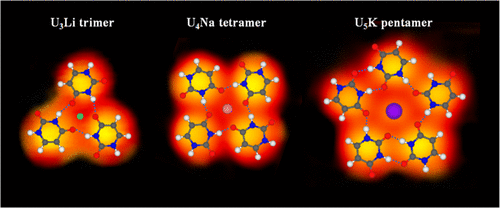当前位置:
X-MOL 学术
›
J. Phys. Chem. C
›
论文详情
Our official English website, www.x-mol.net, welcomes your feedback! (Note: you will need to create a separate account there.)
Real-Space Evidence of Trimeric, Tetrameric, and Pentameric Uracil Clusters Induced by Alkali Metals
The Journal of Physical Chemistry C ( IF 3.7 ) Pub Date : 2020-02-19 , DOI: 10.1021/acs.jpcc.0c00188 Yuanqi Ding 1 , Xinyi Wang 1 , Donglin Li 1 , Wei Xu 1
The Journal of Physical Chemistry C ( IF 3.7 ) Pub Date : 2020-02-19 , DOI: 10.1021/acs.jpcc.0c00188 Yuanqi Ding 1 , Xinyi Wang 1 , Donglin Li 1 , Wei Xu 1
Affiliation

|
Alkali metal cations are known as the significant participants in biological processes and play the vital role in nucleic acid structures. The interactions between alkali metals and nucleobases have therefore attracted a lot of attention. As a peculiar nucleobase in RNA, uracil with its magic number clusters induced by alkali metals has attracted tremendous interest over the past decades. Here, from the interplay of high-resolution scanning tunneling microscopy imaging and density functional theory calculations, we show the real-space evidence of the formation of trimeric, tetrameric, and pentameric uracil clusters induced by alkali metals (Li, Na, and K) on the Au(111) surface, and further investigate their specific configurations at the atomic-scale, which would be of importance for understanding the formation process of biologically relevant nanostructures involving cations in vivo.
中文翻译:

碱金属诱导的三聚体,四聚体和五聚体尿嘧啶簇的真实空间证据
碱金属阳离子是生物过程中的重要参与者,在核酸结构中起着至关重要的作用。因此,碱金属和核碱基之间的相互作用引起了很多关注。作为RNA中独特的核碱基,在过去的几十年中,尿嘧啶及其由碱金属诱导的幻数簇引起了人们极大的兴趣。在这里,从高分辨率扫描隧道显微镜成像和密度泛函理论计算的相互作用,我们显示了由碱金属(Li,Na和K)诱导的三聚体,四聚体和五聚体尿嘧啶簇形成的真实空间证据。在Au(111)表面上,并进一步研究它们在原子尺度上的特定构型,体内。
更新日期:2020-02-19
中文翻译:

碱金属诱导的三聚体,四聚体和五聚体尿嘧啶簇的真实空间证据
碱金属阳离子是生物过程中的重要参与者,在核酸结构中起着至关重要的作用。因此,碱金属和核碱基之间的相互作用引起了很多关注。作为RNA中独特的核碱基,在过去的几十年中,尿嘧啶及其由碱金属诱导的幻数簇引起了人们极大的兴趣。在这里,从高分辨率扫描隧道显微镜成像和密度泛函理论计算的相互作用,我们显示了由碱金属(Li,Na和K)诱导的三聚体,四聚体和五聚体尿嘧啶簇形成的真实空间证据。在Au(111)表面上,并进一步研究它们在原子尺度上的特定构型,体内。


































 京公网安备 11010802027423号
京公网安备 11010802027423号